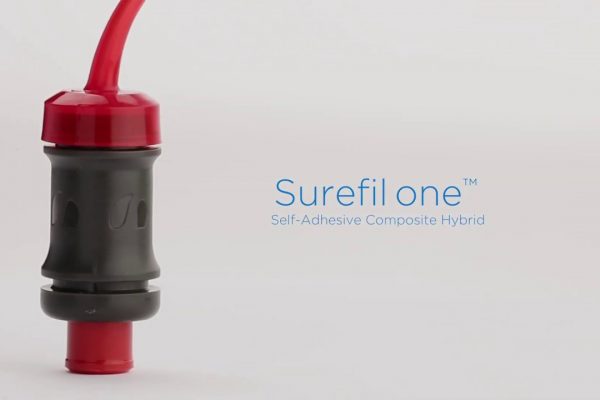Philip Lewis looks at Surefil One, the new self adhesive bulk fill composite from Dentsply Sirona.
In my view, the placement of composite restorations is one of the most exciting aspects of dentistry.
There’s the excitement of wondering whether the patient is going to hold their mouth open long enough for you to reliably complete the time-consuming procedure. The excitement of hoping the tooth has remained uncontaminated throughout the multiple stages of preparation and placement. And the thrill of finding out subsequently if the material was fully cured; not to mention the delicious anticipation of the possibility of post-operative sensitivity.
If you love enjoying these daily adventures, continue doing exactly what you’ve been doing up to now. If not, try Surefil One!
Surefil One
Surefil One is a new bulk-fill, dual-cured self adhesive composite from Dentsply Sirona. It launched in the UK in February 2021. The material has already been in use in Europe for several years and has undergone extensive testing and research.
We are already familiar with self-adhesive luting cements. But this is the first time a viable permanent filling material with these properties has been introduced.
No etching, no bonding. No cavity conditioning; just cavity preparation and filling.
To achieve this, innovated chemistry has been developed, which allows cross-linkage to all components without the inclusion of BIS-GMA. The material is stable in an aqueous environment, eliminating the need to produce both hydrophilic and hydrophobic interfaces.
Another benefit is long-term fluoride release. A full account of this chemistry is provided on the Surefil website.
Benefits
The material offers numerous benefits in clinical practice.
By simplifying the composite workflow there are less chances of errors creeping in. Etching and bonding procedures are eliminated. The dual-cured nature of the material allows bulk-fill to any depth without the need for separate liners.
From the start of mixing the material sets in about six minutes. However, light-curing the surface allows occlusal finishing before removal of the matrix.
By avoiding the need for incremental placement and light curing of each increment, the total time to complete the restoration is much reduced, which is a benefit for both operator and patient.
The mechanical properties of Surefil One are comparable to other composites and include good shear bond strength, surface hardness and durability. Postoperative sensitivity has been reported at less than 1%.
When purchasing the material the starter pack includes capsules of A1, A2, A3 and Bleach shade. Along with an applicator gun and instructions for use.
Using Surefil One
Using Surefil One is easy. First check the bite to avoid direct contact where the proposed restoration will join the tooth. Normal tooth preparation following standard minimally-invasive guidelines follows. Place a matrix.
The capsule is activated by pressing its plunger fully in then placing in a capsule mixer for 10 seconds.
The capsule is then placed in the delivery gun and extruded into the base of the cavity. Clinician will then work all around the preparation and slowly withdraw the capsule until the cavity is slightly overfilled.
Initial shaping can then take place with hand instruments until the end of the 90-second working time. At this stage, the clinician can light-cure the surface of the material for 20 seconds; then occlusal finishing can begin.
Six minutes after mixing, remove the matrix, check the bite again and complete the final finish.
Other considerations
Cavity design
Finish cavity margins with a butt joint. Avoid the use of bevels.
Because of its dual-cure properties, Surefil One is very appropriate for deep and extensive cavities, but is not suitable for direct pulp-capping. In cases where less than 1mm of dentine remains between the cavity floor and the pulp, I recommend the use of a calcium hydroxide lining.
Finish cavities with fine diamond or tungsten burs. Coarse diamonds do not produce a suitable surface finish.
Isolation
Contamination with blood, saliva or excessive moisture during placement spoils all dental materials (including amalgam). Therefore I recommend the use of rubber dam.
Ensure alternative good isolation with cotton rolls or other aids to protect the material during placement.
Matrix
Unlike amalgam, it is not possible to condense composite. So, in order to produce tight contacts, use either sectional or pre-wedged dead soft matrix.
Employing Siqveland-type or Tofflemire-type matrices for example will result in a gap between the proximal surfaces of filling and the adjacent tooth.
Light curing
In most cases a 20-second cure with an efficient curing lamp is sufficient. Where the occlusal surface is wider than the diameter of the tip of the curing lamp, a second 20-second cure, working around the cavity margins, will ensure that the material has adequately hardened to enable finishing to take place.
Aesthetics
Because of the need to finish the cavity margin with a butt joint rather than with a bevel, this compromises the aesthetics of anterior fillings.
There are no magic bullets in dentistry. Surefil One is not a replacement for layered composite or composite veneers in the aesthetic zone. But it is an exceptionally useful addition to our clinical armamentarium for just about everything else.
I’m still excited by composites, but now for all the right reasons!
Follow Dentistry.co.uk on Instagram to keep up with all the latest dental news and trends.
The post Surefil One – new self adhesive bulk fill composite appeared first on Dentistry.co.uk.


